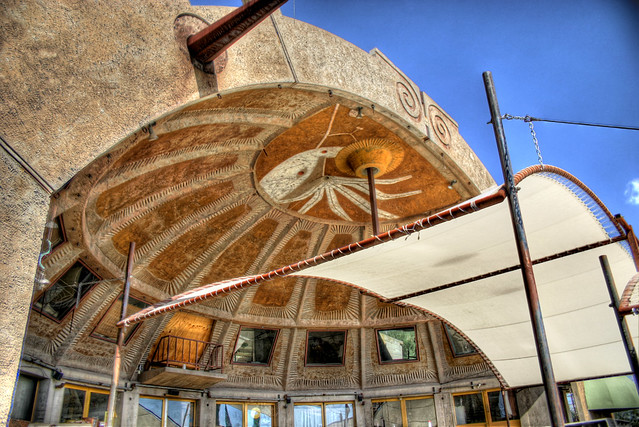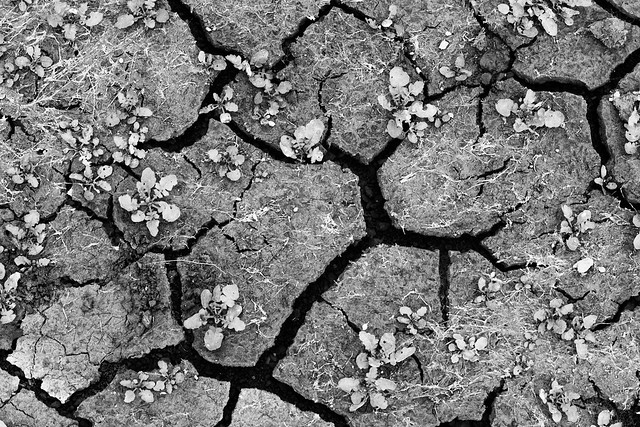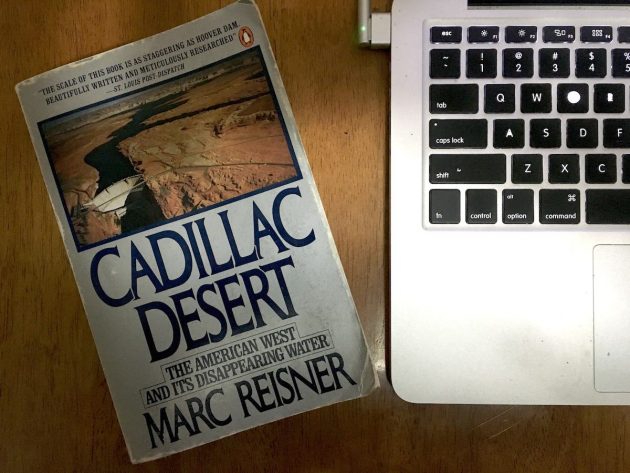I’m reading along side Bryan Alexander and others in his “near-future” science fiction reading “club” (is it a club? a group?). What does one do in a reading group? I guess you read!
Outlining the reasons for joining along and the braided stream of connections to his choice of Paolo Bacigalupi’s The Water Knife may make it many scrolls before I even get to the book.
Bryan published his first post at his 52% depth gauge into the book. I’m almost at the same level in the tank, just about ready to go into chapter 24, I am 55.8% into it.
One of the many reasons the book relates to me is where it is set; in the arid southwest, some in Las Vegas, but mostly centered in a near future Phoenix where water is scarce, and where I have lived since 1987. Having come here to study Geology, that might be part of my own interest in how this place even works as major city in a place lacking water in place.
The interest may have started in my love of the King of Desert rats (that’s an honorable term) Edward Abbey, where the extremes of the desert and his disdain (but acceptance) of urbanization mingle, sometimes monkey wrenching – the idea of environmentalists possibly blowing up the damn creating Lake Powell (or Lake Foul as Hayduke would call it) happens at another dam in the book (though not for the same reasons). The precedent was a 1981 stunt by Earth First where they unfurled a 300 foot poster simulation of a crack on Glen Canyon Dam.
Abbey’s writings likely led me to Charles Bowden; my Geology interests got me to John McPhee’s Basin and Range, perhaps one of the most approachable things to read and learn about Geologists.
That took me to McPhee’s Encounter of the Archdruid which gets to the heart of the battle between environmentalists wishing to keep rivers free and those in the 1960s who sought to contain, control, and manage them for power and delivering water to cities built in places that could sustain populations otherwise. McPhee’s book is how two opponents on the issue, the Sierra Club’s David Brower and the Bureau of Reclamations Floyd Dominy go on a river trip together in the Colorado River through Glen Canyon, what is now buried by Lake Powell. It’s startling to think of people with completely polar opinions on an issue to spend that much time together listening to each other. It almost sounds like non-fiction.
But nothing I have read provides more insight to understanding the water issues in the American southwest is Marc Reisner’s Cadillac Desert
My weather beaten copy has written inside a date of 1990, right in the middle of my Geology grad school era at Arizona State University. I cannot recommend a book more highly. The recipe for what plays out as the plot of The Water Knife is outlined by Reisner:
- A land that few people knew first hand in the mid 1900s, remote and distant from the east coast.
- Battling bureaucracies and big egos at work at the Bureau of Reclamation and the Army Corps of Engineers
- The dividing of water flowing through the Colorado River by decree of the 1922 Colorado River Compact between the 7 states that the river flows through. The allocations were based on water flow of of an era of unusually high flow and climate conditions different from now. The states are now allowed by that law the same amount of water, but the supply is much less.
It’s no surprise that Cadillac Desert is mentioned so referentially in The Water Knife, multiple times. Characters have valuable first editions. When Mike Ratan offers his copy to young Maria, he describes it, “It’s kind of how we got where we are now… I think people should start with this. It’s the bible when it comes to water.”
And its even more telling when Maria refuses the book. Her condition is so desperate, she has no need to understand history. She rejects history:
She glared at him. “I don’t need books about how things used to be. Everybody talks about how things used to be, I need a book about how I’m supposed to live now. Unless you got a book like that, I don’t need the weight.” She flicked her hand at the thing, lying in the counter. “I mean, seriously. It’s paper.”
A week or so before he chose The Water Knife, Bryan included me on an email to a few people where he shared:
Very interesting futures work around Phoenix:
https://www.researchgate.net/publication/303815839_Designing_an_Experiential_Scenario_The_People_Who_Vanished“The name Hohokam is an O’odham word meaning “the people who vanished” (Mays & Gorokhovich, 2010). Being an oral culture, it is unknown what they called themselves. So a question which we hoped to evoke for participants at Emerge became: “could the people of today’s Phoenix be the next to vanish from the valley?””
While there is a citation there, my memory of what I had known about the Hohokam, was that the O’odham meant “All Used Up” (that is used in The Water Knife too as well as Wikipedia), so my reply (not that this is an expertise of mine) was:
They might check their research better. What I remember (and look it up in Wikipedia) is the word Hohokam was derived from means “used up”. Their culture was not just in the Valley of the sun, it reached well into southern Arizona, past Tucson, including the massive structure still standing at Casa Grande, and north almost to Flagstaff.
Their culture, from like 800-1300 or 1400 grew from agricultural to city centers sophisticated, with established trade with other cultures, there are ball courts. The canal systems Howard describes were all created with hand tools, and I’ve heard they have grades that drop only inches per mile, irrigating off of the Salt River. The climate then was likely different from now; that bone dry river you see now in Phoenix flowed much more regularly. I don’t think you can compare the modern to the ancient living. Temperatures are several degrees warmer year to year from the effect of all the concrete and asphalt covering the land. Plus people several hundred years ago did not complain about the heat in social media, they adapted 😉
They weren’t the only cultures to vanish in the southwest, high civilizations also vanished without known reasons from the Pueblo cultures of northern AZ and New Mexico, including Chaco Canyon. It’s still debated if it was climate change (long term drought?), there were theories that the effort in building cleared major forests, and changed erosional patterns’ or maybe it was disease that spread rampantly, or maybe it was just good old fashioned violence.
Las Vegas probably has more to worry about than Phoenix; they are having to spend billions to re-engineer their pumping system from a dropping Lake Mead; I heard a news story that at least Vegas was able to reduce consumption by 40%.
I am not expert, and I only skimmed their article, but more homework might be in order. It was not one tribe vanishing from Phoenix, it was a broader crises.
Still could happen, though.
Keep in mind that there were about 400 years between the disappearance of the Hohokam and the arrival of Mormon settles who “discovered” their canals.
That story about Lake Mead having to build a “third straw” comes in to play to in the Water Knife.
Despite all my reading into the issues of water supply, I must admit I really like my long hot showers (well when I am not home because my hot water heater is small, and does not last too long). I sometimes get lost in thought, and I am pretty sure some of my best ideas from the few months I was on fellowship at Thompson Rivers University in 2014-2015… came from the shower.
Sometimes I step back and wonder about how easy it is to take for granted a large amount of clean, and when we want, warm, water pouring out of the wall. What if we lived in a time where that was an unreasonable luxury? While staying last year in an AirBnB in Chicago, the older apartment’s shower felt like a possible setting for a time when the water… stopped. I had made a really short video, but I noticed I had not published it.. until tonight.
What would it be like, to be… waterless?
I did write Bryan at that time, because I was wondering if he knew of any science fiction of a time when water was not plentiful. He recommended a short story called The Tamarisk Hunter with a link to a podcast audiobook version:
“The Tamarisk Hunter” originally appeared in the environmental journal High Country News. It was inspired by the only thing that really matters in the Western U.S. — water.
Tamarisk or Salt Cedar are one of those many times when people thought it was a good idea to introduce a plant species that becomes an invasive horror story. They have invaded and crowded out native plants in every southwestern river system, and they consume a huge amount of water.
The story again was a near future time when water was scarce, states fought over rights, and seems like a precursor to the Water Knife. And there is a good reason… the author of the Tamarisk Hunter was this person named… Paolo Bacigalupi (also available on Paolo’s site).
And Bacigalupi references his earlier work in The Water Knife when Angel tells Lucy:
You know that tamarisk hunters, in the old days, would always share water when they met each other on the Colorado?
But the connection with this book goes deeper. Last summer while visiting my friends in Paonia, we were discussion science fiction, and I brought up this story— my hosts Ken and Oogie knew the story before I finished describing it. Even more, they knew the author, because Paolo lives in the same small town. they said he does a lot of his writing in the local hangout, Revolution Brewery.
That’s all my prelude to The Water Knife.
But I am loving this book for many reasons- it’s in a setting I know well, so when they mention an area known as “PV” I know they are talking about Paradise Valley. The suburban Phoenix, though in part ruins in the story, are places I am familiar with.
The chapter swirls through three characters that are not connected in the beginning, though as the story spins, we know there is a connection. None of them seem too likely a heroic character, and they in a way all feel doomed (I am only 55.8% through).
The very book title is interesting if you pick at it. What is a “water knife”? Obviously a knife made of water would be useless. But we know soon it is a name for what Angel does for water boss Catherine Case in Vegas, he literally cuts the water supply of other places (blowing up canals, destroying a water plant, or just killing people in the business) to bolster the supply for Vegas.
But think again- he does not cut the water, he cuts all the things, people that provide the water. And Angel denies what he is (as a cover? confuser?):
“Water knives don’t exist,” he said. “That’s just something people talk about. It’s a myth, right? Like the chupacabra. It’s just something people make up so they can have a bogeyman to blame when shit goes wrong.”
I love that he uses chupacabra (“goat sucker”) a word I learned about while in Puerto Rico, where the story likely originated from:

flickr photo shared by cogdogblog under a Creative Commons ( BY ) license
The setting is not a distant low water future like Dune — it is so close it could be… now. But not all. The design of the “arcology” structures, the reclaiming of water in a way to sustain life for a smaller number of (privileged) people (made possible by water knifing the supplies of those left outside). While plausible, the arcology is still conceptual.
And again, there is a local connection- the concept of a self contained sustainable architecture comes right from the ideas of Paolo Soleri, who used it to describe his ideas for Arcosanti (halfway between Phoenix and Flagstaff).

flickr photo shared by CodyR under a Creative Commons ( BY ) license
Are you following the lines? The ideas of Paolo Soleri are used by author Paolo Bacigalupi.
There are “data glasses” used to identify people, again, near futuristic. The digital water meters at sinks. The ClearSac for the less fortunate to turn urine into water (it sounds like it was partly effective). An ecstasy-like drug called “Bubble”.
I like how they talk disparaging of Arizona people as “Zoners”– in reality it’s a term I remember people in Sn Diego calling all the people from here who go there for vacation, though they call us “Zonies”.
What does not seem implausible is the quasi breakdown of social order in light of environmental crises, the diminishing national power as states do things like use militias to keep the “waterless” (mostly the Texans apparently driven out by hurricanes and sea floor rising). It seems interesting that Las vegas would turn out to be a power player, perhaps driven to be more “Scrappy” by having maybe the least access to water. You think that Catherine Case is the real power player, but it takes a while to realize that the real power holders and the ones to fear are “Calis” or Californians.

flickr photo shared by cogdogblog under a Creative Commons ( BY ) license
This fits into the story of water history of Cadillac Desert, and you read of the schemes that have drained Mono Lake for moving water 300 miles to Los Angeles (and of course the movie Chinatown). Lucy gives Angel a lecture on this:
California. Those people know how to play the game. Los Angeles, San Diego. The Imperial Valley companies. These people know how to fight for water. It’s in their veins. Their blood. They’ve been killing places for water for five generations. They’re good at it.
And this is what makes the book so good to me- it’s a novel, it’s a near future, but it completely is in sync with the history of water in the southwest, its division by a likely uneasy “pact” between the states that shared the water, and how that might crumble when the water drastically is decreased.
I’ve not read how this happened, and there probably is no inciting event. This is not a future story driven by an aliens from outer space or an asteroid, it is not even an apocalypse because it just happens gradually. That’s what makes it realistic science fiction.
Also, with 44.2% to go, I have no idea what is going to happen. I am thinking it’s not going to end happily. But I’m hooked on this book.

flickr photo shared by cogdogblog under a Creative Commons ( BY ) license
Top / Featured Image: I went to my own flickr photos, I had a few possible photos of mud cracks in dry lake beds, but when I searched on “dry” for some reason this one of an old water fixture, rusty, disconnected, called to me. You ought to listen to those calls.
This is in the back of my friend’s restaurant, the Randall House in Pine, AZ (if you like the web site, thanks), and the photo is on flickr https://flickr.com/photos/cogdog/14522849444 and shared under a Creative Commons (BY) license



This conversation is now going on on several domains, which is kinda cool.
It is so interesting to me the crazy quilt of associations you bring to this book. I actually found those more interesting than the book, which was a little too dark for me.
With permission I reblogged Bryan’s first round of thoughts on the book and then added my own review. I will add a link back to this good blog article, too.
http://www.booksmyfriendshavewritten.com/paolo-bacigalupi-the-water-knife/
Thanks Sandy– I spotted your post the other day “there’s another site that Sandy does I’ve not seen.
The book cannot help but be dark. No happy endings without water.